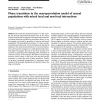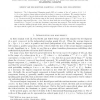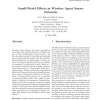43 search results - page 6 / 9 » Percolation in the Secrecy Graph |
BC
2005
13 years 7 months ago
2005
Abstract We model the dynamical behavior of the neuropil, the densely interconnected neural tissue in the cortex, using neuropercolation approach. Neuropercolation generalizes phas...
STOC
2004
ACM
14 years 15 days ago
2004
ACM
Several peer-to-peer networks are based upon randomized graph topologies that permit efficient greedy routing, e.g., randomized hypercubes, randomized Chord, skip-graphs and const...
SIVP
2010
13 years 5 months ago
2010
Resource aware operation of sensor networks requires adaptive re-organization to dynamically adapt to the operational environment. A complex dynamical system of interacting compone...
RSA
2010
13 years 5 months ago
2010
The 2-dimensional Hamming graph H(2, n) consists of the n2 vertices (i, j), 1 ≤ i, j ≤ n, two vertices being adjacent when they share a common coordinate. We examine random sub...
IJWMC
2010
13 years 4 months ago
2010
Coverage, fault tolerance and power consumption constraints make optimal placement of mobile sensors or other mobile agents a hard problem. We have developed a model for describin...



